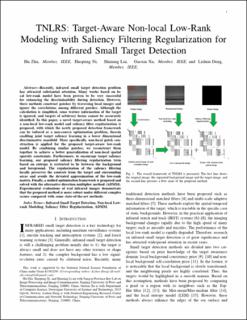| dc.description.abstract | Recently, infrared small target detection problem has attracted substantial attention. Many works based on local low-rank model have been proven to be very successful for enhancing the discriminability during detection. However, these methods construct patches by traversing local images and ignore the correlations among different patches. Although the calculation is simplified, some texture information of the target is ignored, and targets of arbitrary forms cannot be accurately identified. In this paper, a novel target-aware method based on a non-local low-rank model and saliency filter regularization is proposed, with which the newly proposed detection framework can be tailored as a non-convex optimization problem, therein enabling joint target saliency learning in a lower dimensional discriminative manifold. More specifically, non-local patch construction is applied for the proposed target-aware low-rank model. By combining similar patches, we reconstruct them together to achieve a better generalization of non-local spatial sparsity constraints. Furthermore, to encourage target saliency learning, our proposed saliency filtering regularization term based on entropy is restricted to lie between the background and foreground. The regularization of the saliency filtering locally preserves the contexts from the target and surrounding areas and avoids the deviated approximation of the low-rank matrix. Finally, a unified optimization framework is proposed and solved with the alternative direction multiplier method (ADMM). Experimental evaluations of real infrared images demonstrate that the proposed method is more robust under different complex scenes compared with some state-of-the-art methods | en_US |
